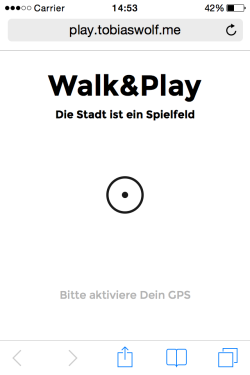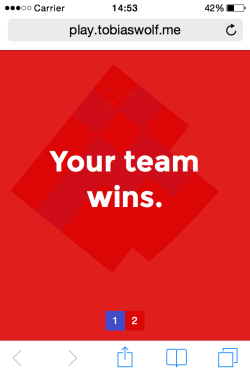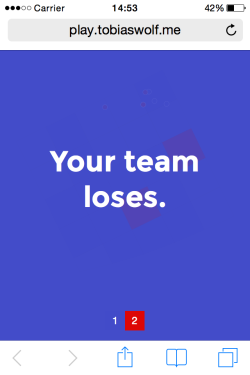Psychogeography:
The city becomes a playground.
The pavement of Weimar's market square visually divides it into 25 square fields. These serve as the playing field. To participate in the game, the player visits the website with his smartphone.
One of the fields is highlighted. The player himself is represented as a circle on the playing field. He is automatically associated with one of two teams. Depending on this, his avatar appears in the corresponding color. If he moves, his movement is also visible on the screen.
The game dynamics depend only on the highlighted field. When all players of a team are in the highlighted field, it is displayed in the team color and a new random field is highlighted for an upcoming conquest.
The team that can win more than half of all fields first also wins the set. The board is reset and a new set begins.
The game is endless.
Screen design




Concept
Idea
Problem
The public life of our cities is dull. Every movement is organized by signs and paths. Traffic and consumption are clearly the focus of the design of public space. Especially in road traffic it is subject to strict rules. Those who move in public obey the rules of the places: Don't walk on red. Do not stop in the middle of the road. Do not touch. Do not run. Do not attract attention.
Scenario
Let's imagine using the structure of public space to play. Playing with strangers not in virtual space, but in physical space. It should be possible to join the game and leave it again whenever you want. The game should work alone and in large groups. The machine (the smartphone) is not a platform but serves to support the real game world.
Theory reference
The described context is closely related to the subject of psychogeography. This "investigates the influence of the architectural or geographical environment on perception, psychological experience, and behavior."
en.wikipedia.org/wiki/Psychogeography
Implementation
Objective
The tension between self and public in the context of the described scenario can be outlined by further questions:
How does our perception of the physical public change when it serves as a playing field? And to what extent can we emotionally engage in a game that takes place in public?
How do I behave toward teammates? How much does my behavior toward opponents differ from teammates? And how is social interaction different from that in virtual games?
Which game methodology is compatible with the special psychological effects of playing together in public?
Method
The pavement of the Weimar marketplace visually divides it into 25 square fields. These serve as the playing field in the prototype. To participate in the game, the player visits a website with his smartphone. The URL of the website is to be spread by local guerrilla marketing (stickers, etc.). Once he visits the website he is asked to join the marketplace.
When he reaches the marketplace (tolerance limit of a few meters) the structure of the playing field appears on the screen. One of the fields is highlighted. The player himself is shown as a circle on the playing field. He is automatically associated with one of two teams. Depending on this, his avatar appears in the corresponding color. If he moves, his movement is also visible on the screen.
The game dynamics depend solely on the highlighted field. As soon as a player enters it, it tends to take on its own team color. The more players from the same team enter the field, the more intense the hue becomes. If the number of players from the other team predominates, the color changes.
Only when all the players of a team are in the corresponding field, it is completely displayed in the team color and a new, random field is highlighted for an upcoming conquest.
The team that can first win more than half of all fields for itself also wins the set. The playing field is reset and a new set begins.